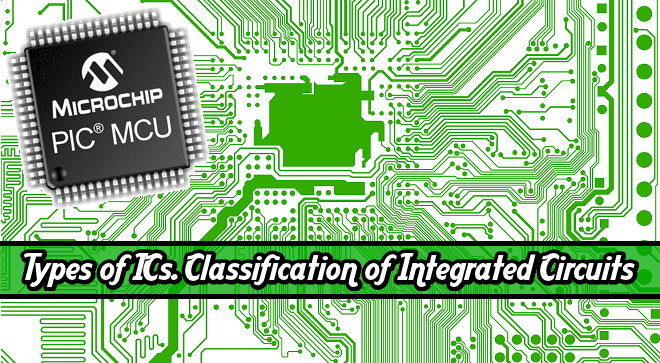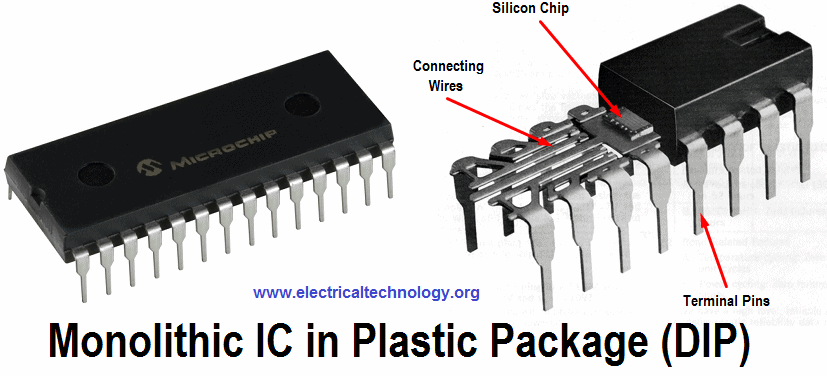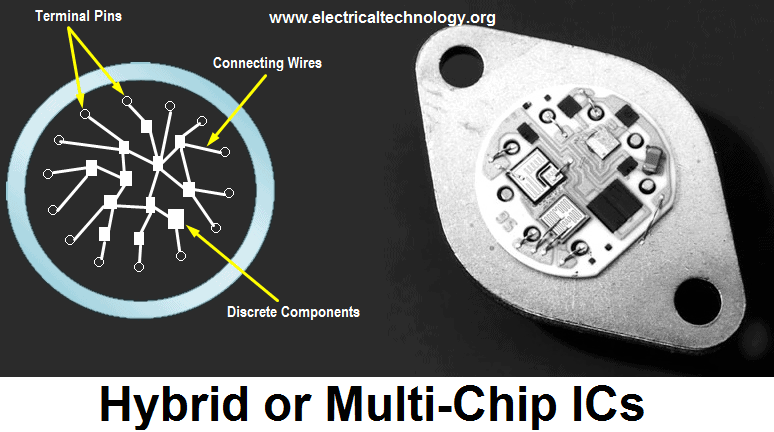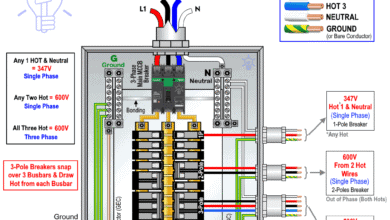Types of ICs. Classification of Integrated Circuits and Their Limitation
Different Types of Integrated Circuits (ICs) & Their Applications & Limitation
Introduction to ICs (Integrated Circuits)
Integrated circuit (IC) is the most significant technological development of the 21st century if I may say. It has forever transformed the world of electronics. It has reduced the size of electronics from a refrigerator size to palm size electronics or even less.
Unlike vacuum tubes used in early electronics, ICs dissipates less heat and as consumes less energy compared to vacuum tubes. Its reliability is not to be compared with that of vacuum tubes, it is very reliable. ICs have changed the fate of electronics.
It has cut down the prices of electronics; it also changed the design of electronics from the use of discrete (separate) electronic components to hybrid solid-state devices which combine discrete components with ICs. ICs are so small that you cannot see the connections between them unless with the help of a microscope. Thus ICs are immensively in use in our electronics and almost all control devices.
An IC consists of interconnected transistors, capacitors, resistors, diodes etc. These components are interconnected with an external connecting terminals contained in a small package.
Classification of ICs (Integrated Circuits)
Below is the classification of different types of ICs basis on their chip size.
- SSI: Small scale integration. 3 – 30 gates per chip.
- MSI: Medium scale integration. 30 – 300 gates per chip.
- LSI: Large scale integration. 300 – 3,000 gates per chip.
- VLSI: Very large scale integration. More than 3,000 gates per chip.
Types of ICs (Integrated Circuits)
Based on the method or techniques used in manufacturing them, types of ICs can be divided into three classes:
- Thin and thick film ICs
- Monolithic ICs
- Hybrid or multichip ICs
Below is the simple explanation of different types of ICs as mentioned above.
Thin and Thick ICs:
In thin or thick film ICs, passive components such as resistors, capacitors are integrated but the diodes and transistors are connected as separate components to form a single and a complete circuit. Thin and thick ICs that are produced commercially are merely the combination of integrated and discrete (separate) components.
Thick and thin ICs have similar characteristics, similar appearance except the method of film deposition. Method of deposition of films distinguished Thin ICs from Thick ICs.

In Thick film ICs, silk printing technique is used to create the desired pattern of the circuit on a ceramic substrate. Thick-film ICs are sometimes referred to as printed thin-film.
The screens are actually made of fine stainless steel wire mesh and the links (connections) are pastes having conductive, resistive or dielectric properties. The circuits are fired in a furnace at a high temperature so as to fuse the films to the substrate after printing.
Monolithic ICs
In monolithic ICs, the discrete components, the active and the passive and also the interconnections between then are formed on a silicon chip. The word monolithic is actually derived from two Greek words “mono” meaning one or single and Lithos meaning stone. Thus monolithic circuit is a circuit that is built into a single crystal.
Monolithic ICs are the most common types ICs in use today. Its cost of production is cheap and is reliable. Commercially manufactured ICs are used as amplifiers, voltage regulators, in AM receivers, and in computer circuits. However, despite all these advantages and vast fields of application of monolithic ICs, it has limitations. The insulation between the components of monolithic ICs is poor. It also have low power rating, fabrication of insulators is not that possible and so many other factors.
In term of Electronics or microelectronics, a dual in-line package (DIP or DIL), or dual in-line pin package (DIPP) is an electronic component package with a rectangular housing and two parallel rows of electrical connecting pins.
Hybrid or Multi chip ICs
As the name implies, “Multi”, more than one individual chips are interconnected. The active components that are contained in this kind of ICs are diffused transistors or diodes. The passive components are the diffused resistors or capacitors on a single chip.
These components are connected by metallised patterns. Hybrid ICs are widely used for high power-amplifier applications from 5W to more than 50W. Its performance is better than that of monolithic ICs.
Digital Integrated Curcuits
These types of ICs work on the basic digital system i.e. two defined level which is 0’s and 1’s (in other words, Low and High or ON and OFF respectively). Microprocessor and Micro controller is the example of Digital ICs which contains of million of flip flops and logic gates.
Analog Integrated Circuits
Analog ICs work by processing continuous signals i.e. analog signal. OP-AMP (Operational Amplifier), NE 555 Timers and Sensors are the example of Analog ICs. These types of ICs are used for amplification, filtering, modulation, demodulation etc.
Mixed Signal ICs
Mixed Signal Integrated Circuit is a kind of ICs where both Digital and Analog ICs are combine on a single chip.
Advantages and Applications of ICs
ICs have advantages over those that are made by interconnecting discrete components some of which are its small size. It is a thousand times smaller than the discrete circuits. It is an all in one (components and the interconnections are on a single silicon chip). It has little weight.
Its cost of production is also low. It is reliable because there is no soldered joints. ICs consumes little energy and can easily be replaced when the need arises. It can be operated at a very high temperature. different types of ICs are widely applied in our electrical devices such as high power amplifiers, voltage regulators, TV receivers and computers etc.
Limitation for different types of ICs
Despite the advantages that ICs provide us with, it have limitations some of which are:
- Limited power rating
- It operates at low voltage
- High grade of PNP is not possible
- It produces noise during operation
- Its components such as resistors and capacitors are voltage dependent
- It is delicate i.e it cannot withstand rough handling etc.
You may Also read:










Please tell about motor dc brushless. thank you
please. How will i know which integrated circiut (IC) is an anolog or digital or monolicthic IC ?.
There is a number writen on every chips what is it for?
1. IC Type Classification
– Analog ICs: These ICs work with continuous signals. They are used in applications such as amplifiers, oscillators, and signal processing. Examples include operational amplifiers (op-amps) and voltage regulators.
– Digital ICs: These ICs work with binary signals (0s and 1s). They are used in logic circuits, processors, memory devices, and microcontrollers. Examples include logic gates, microprocessors, and flip-flops.
– Monolithic ICs: This term refers to ICs that are manufactured on a single semiconductor substrate. Most modern ICs, whether analog or digital, are monolithic.
2. IC Number and Identification
The number printed on an IC is usually a part number or model number that identifies the specific IC. This number can tell you the following information:
– Manufacturer: The first part of the number often indicates the manufacturer (e.g., “SN” for Texas Instruments).
– IC Function: The rest of the number represents the specific function or series of the IC. For example, “555” is a well-known timer IC.
To know whether the IC is analog, digital, or monolithic:
– Look up the part number: You can search the part number online to find the IC’s datasheet, which provides detailed information about its function and category (analog, digital, or mixed-signal).
– Package codes and series: Some IC series or families are designated for specific types of circuits (e.g., “LM” series from Texas Instruments is typically analog, while “74” series are digital logic ICs).
Example:
– SN74LS00: A digital logic IC (quad 2-input NAND gate).
– LM358: An analog IC (dual operational amplifier).
Key Points:
– Analog ICs handle continuous signals.
– Digital ICs handle binary signals.
– Monolithic refers to ICs built on a single substrate, and most modern ICs are monolithic.
– Part numbers are crucial for identifying an IC’s function, manufacturer, and type.
You can look up the datasheet of any IC using its part number to confirm its category and usage.
An integrated circuit (IC) is a miniature electronic device or component. Using a certain process, a circuit requires transistors, resistors, capacitors inductors, and other components and wiring interconnections together, made in small or several small semiconductor wafers or dielectric substrates, and then encapsulated in a casing to become a miniature structure with the required circuit function; which all the components in the structure of the structure have been made up of an integral whole, so that the electronic components to the micro-miniaturization, low-power consumption, intelligence and High reliability has taken a big step forward. It is represented by the letter “IC” in the circuit.